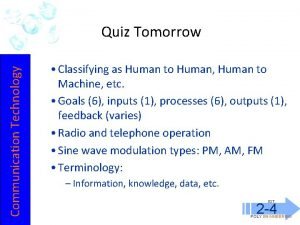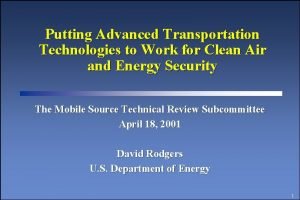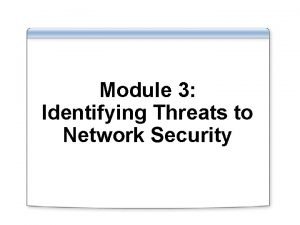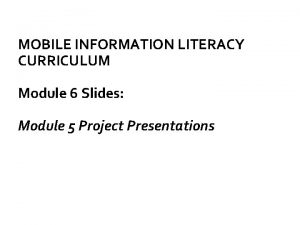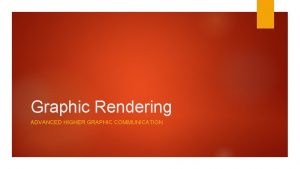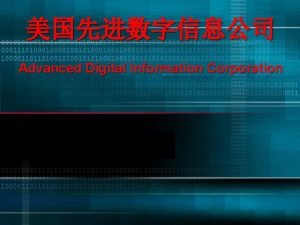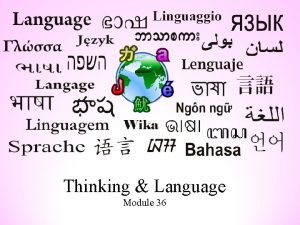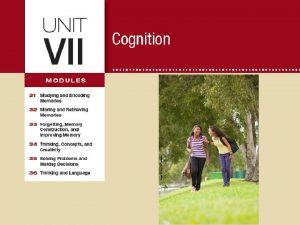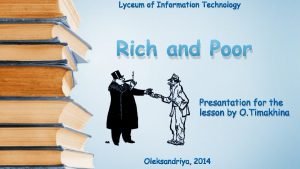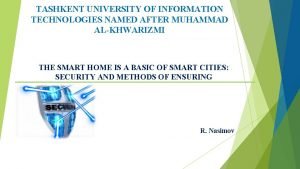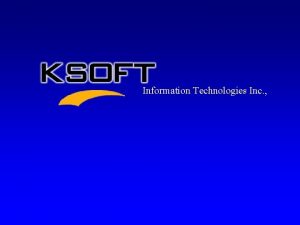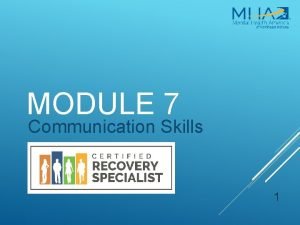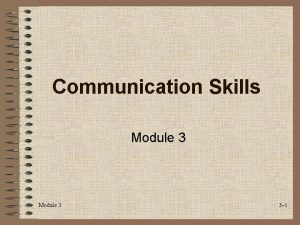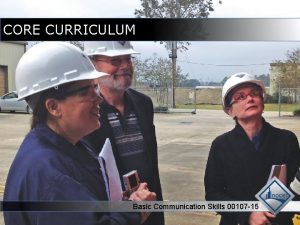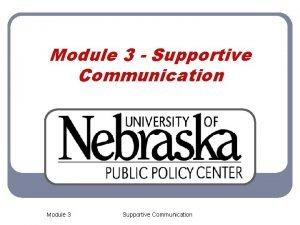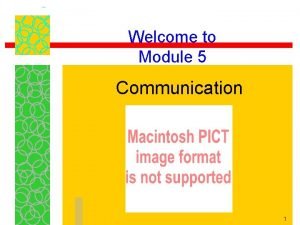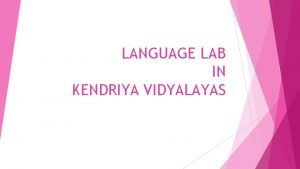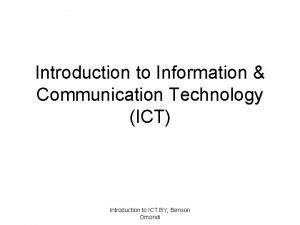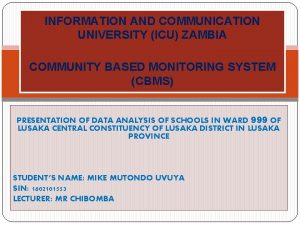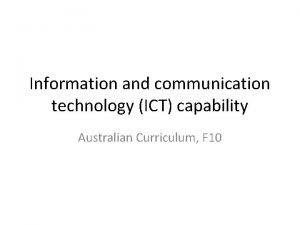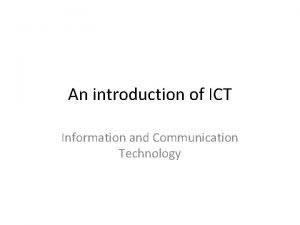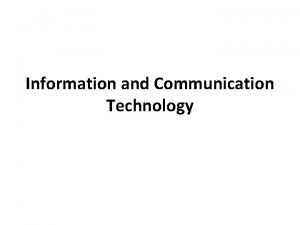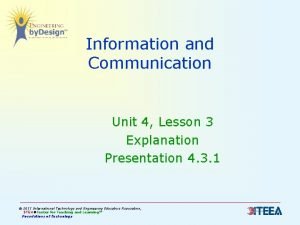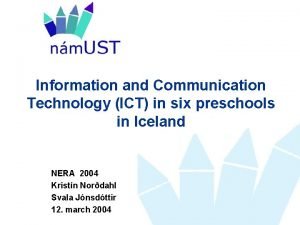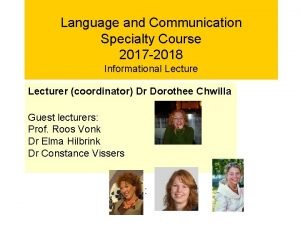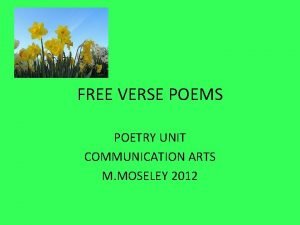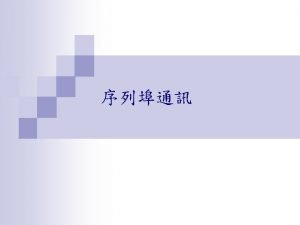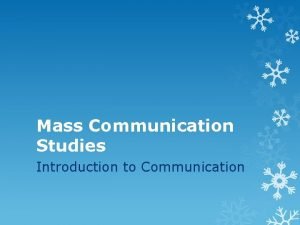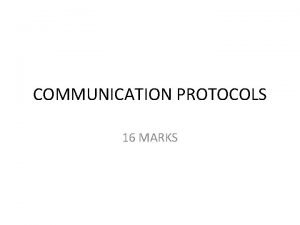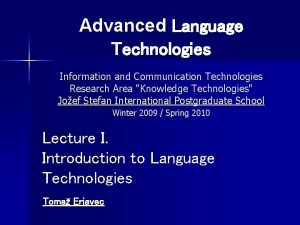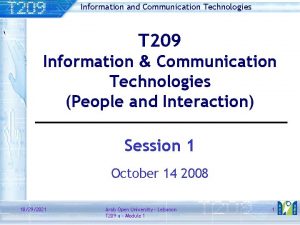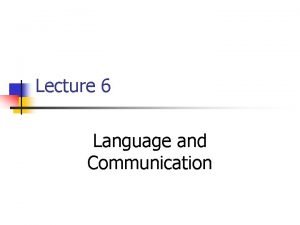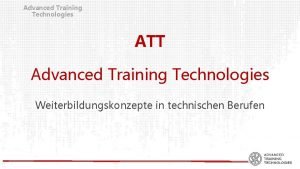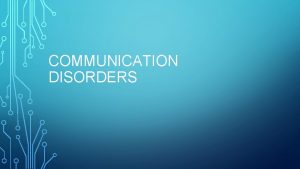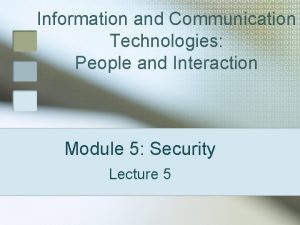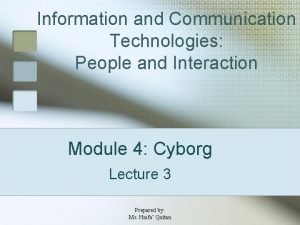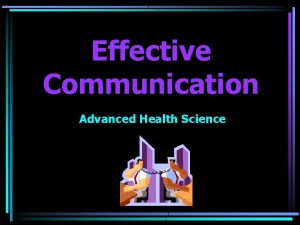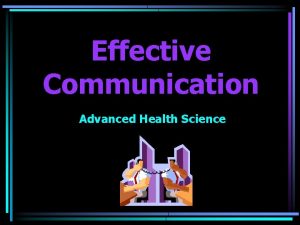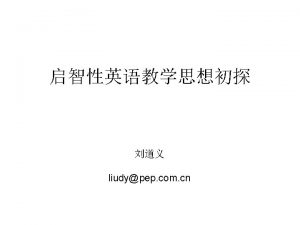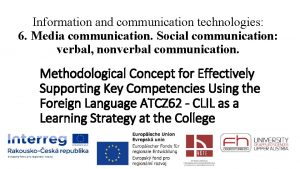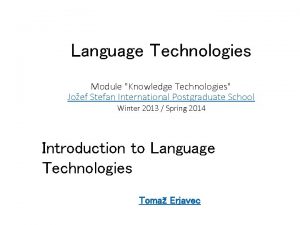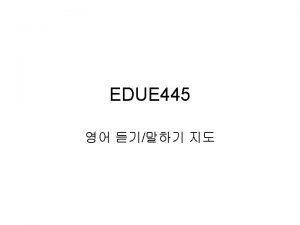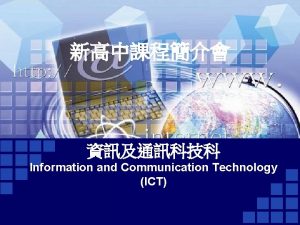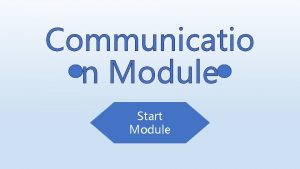Advanced Language Technologies Information and Communication Technologies Module














































- Slides: 46

Advanced Language Technologies Information and Communication Technologies Module "Knowledge Technologies" Jožef Stefan International Postgraduate School Winter 2011 / Spring 2012 Lecture II. Computer Corpora Tomaž Erjavec

Overview of the lecture 1. 2. 3. Background Corpus compilation and markup Morphosyntactic tagging

Background • What is a corpus? • Using corpora • Characteristics of a corpus • Typology of corpora • History • Slovene language corpora

A corpus is: • a large collection of texts • in digital format • language “as it is” • a sample of the language it is meant to represent • used for describing language (descriptive/empirical linguistics) • for computer scientists: a dataset

A more precise definition • Corpus (plural corpora) is Latin for body • Guidelines of the Expert Advisory Group on Language Engineering Standards, EAGLES: • Corpus : A collection of pieces of language that are selected and ordered according to explicit linguistic criteria in order to be used as a sample of the language. • Computer corpus : a corpus which is encoded in a standardised and homogeneous way for open-ended retrieval tasks. Its constituent pieces of language are documented as to their origins and provenance.

Using corpora • Applied linguistics: • Lexicography: making dictionaries (first users of corpora) • Translation studies: translation equivalents with contexts translation memories, machine aided translations • Language learning: real-life examples, curriculum development • Corpus linguistics: • linguistics based not on introspection, but on observation of real data • Language technology: • testing set for developed methods • training set for inductive learning (statistical Natural Language Processing)

Characteristics of a (good) corpus • Quantity: the bigger, the better • Quality : the texts are authentic; the mark-up is validated • Simplicity: the computer representation is understandable, with the mark-up easily separated from the text • Documented: the corpus contains bibliographic and other meta-data

Typology of corpora I. • Medium: • written language • spoken language (spoken, but in writing / transcription) • speech corpora (actual speech signal) • Content: • reference corpora (representative), e. g. BNC • sub-language corpora (specialised), e. g. COLT • Structure: • corpora with integral texts • corpora or of text samples (historical and legal reasons) e. g. Brown

Typology of corpora II • Time: • static corpora • monitor corpora (language change) • Languages: • monolingual corpora • multilingual parallel corpora (e. g. Hansard, Europarl, JRC Acquis) • multilingual comparable corpora • Annotation: • plain text corpora • annotated corpora

Reference corpora • Characteristics: • • • a sample of the “complete” language large, expensive, detailed and explicit design criteria typically of contemporary language documented annotated legally clean, available (but usu. only via a concordancer) • Criteria for including texts: • representativeness: corpus includes “all” text types • balance: the sizes of text type samples are in proportion to their “importance” for the speakers of the language • methodology v. s. practical constraints

History of corpora • First milestones: Brown (1 million words) 1964; LOB (also 1 M) 1974 • The spread of reference corpora: Cobuild Bank of English (monitor, 100. . 200. . M) 1980; BNC (100 M) 1995; Czech CNC (100 M) 1998; Croatian HNK (100 M) 1999. . . • EU corpus oriented projects in the '90: NERC, MULTEXT-East, . . . • Language resources brokers: LDC 1992, ELRA 1995 • Web as Corpus (2000. . ): uk. Wa. C, it. Wa. C, … sl. Wa. C • more, larger, for more languages, with diverse annotations: EUROPARL, JRC-ACQUIS, PDT, …

Slovene language corpora The „FIDA“ monolingual reference corpora (FF, IJS, DZS, Amebis): • FIDA, 1998: 100 M, ambiguous annotations • Fida. Plus, 2006: 600 M, unambiguous • Gigafida, 2012: 1000 M, adds Web materials Freely available training sets: • IJS, FF: JOS corpora (jos 100 k, jos 1 M) • SSJ project: cc. Fida, ssj 400 k Parallel corpora: • IJS: MULTEXT-East 1998 -, SVEZ-IJS, 2004, JRC-ACQUIS, 2006 • SVEZ: Euro. Korpus • FF: TRANS, 2002 Speech corpora: • Laboratory for Digital Signal Processing, University of Maribor: Speech. Dat, ONOMASTICA. . . • Laboratory of Articifical Perception, Systems and Cybernetics, University of Ljubljana: SQEL, GOPOLIS, . . .

II. Compilation and markup of corpora • Steps in the preparation of a corpus • What annotation can be added to the text • Computer coding of corpora • Markup methods

Before making your own corpus check if an appropriate corpus is already available • google • corpora@lists. uib. no • LDC, ELRA

Steps in the preparation of a corpus 1. 2. 3. 4. 5. 6. Choosing the component texts and acquiring digital originals Up-translation to standard format Linguistic annotation Documentation Use Dissemination

Getting the text 1. 2. 3. Choosing the component texts: linguistic and non-linguistic criteria; availability; simplicity; size Copyright sensitivity of source (financial and privacy considerations); agreement with providers; usage, publication Acquiring digital originals OCR; digital originals; Web • Boot. Cat

Processing 1. Conversion to common format consistency; character set encodings; structure • 2. 3. Web as Corpus: Wacky tools Documentation e. g. TEI header; Open Archives etc. Linguistic annotation language dependent methods; errors

Use and dissemination • Using the corpus: • concordancer (linguists) e. g Gigafida, SKE, i. Korpus, JOS, IMP • statistics extraction • development of new methods for analysis • Dissemination: • legalities (source copyright, corpus use agreement) • mode: concordancer or dataset

Computer coding of corpora • Encoding must ensure • durability • interchange between computer platforms • interchange between applications • Basic standard: XML • companion standards: W 3 C Schema, ISO Relax NG, XSLT, XPath, XQuery, . . . • XML vocabulary of annotations of arbitrary texts: Text Encoding Initiative, TEI • ISO TC 37 „Terminology and other language resources“: many standards for text encoding

Corpus annotation • Annotation = interpretation • Documentation about the corpus (example) • Document structure (example) • Basic linguistic markup: sentences, words (example), punctuation, abbreviations (example) • Lemmas and morphosyntactic descriptions (example) • Syntax (example) • Alignment (example) • Terms, semantics, anaphora, pragmatics, intonation, . . .

Example: TEI header <? xml version="1. 0" encoding="utf-8"? > <TEI xmlns="http: //www. tei-c. org/ns/1. 0" xml: lang="sl" xml: id="FPG_00008 -1847"> <tei. Header xml: lang="sl"> <file. Desc> <title. Stmt> <title>AHLib: Zschokke, Heinrich. "Čujte, čujte, kaj žganje dela!" (1847)</title> <principal> <name>Erich Prunč, Univerza Karl-Franzens v Gradcu</name> </principal> <resp. Stmt> <name>Tomaž Erjavec, Institut "Jožef Stefan"</name> <resp>Računalniška obdelava</resp> </resp. Stmt> </title. Stmt> <edition>1. 0</edition> </edition. Stmt> <extent>124 pp</extent> …

Example: text structure <quote id="Osl. 1. 8. 18" rend="center; it"> <lg id="Osl. 1. 8. 1"> <l id="Osl. 1. 8. 1. 1">Tam pod kostanjevim drevesom</l> <l id="Osl. 1. 8. 1. 2">izdala si me, </l> <l id="Osl. 1. 8. 1. 3">izdal sem te, </l> <l id="Osl. 1. 8. 1. 4">ne da bi trenila z očesom. </l> </lg> </quote> <p id="Osl. 1. 8. 19"> <s id="Osl. 1. 8. 19. 1">Trije možje se niso niti ganili. </s> <s id="Osl. 1. 8. 19. 2">Toda ko je <name>Winston</name> znova pogledal v Rutherfordov propadli obraz, je opazil, da so njegove oči polne solz. </s>. . .

Example: morphosyntactic tagging <s id="Osl. 1. 2. 2. 1"> <w lemma="biti" ana="#Vcps-sma">Bil</w> <w lemma="biti" ana="#Vcip 3 s--n">je</w> <w lemma="jasen“ ana="#Afpmsnn">jasen</w><pc>, </pc> <w lemma="mrzel" ana="#Afpmsnn">mrzel</w> <w lemma="aprilski" ana="#Aopmsn">aprilski</w> <w lemma="dan" ana="#Ncmsn">dan</w> <w lemma="in" ana="#Ccs">in</w> <w lemma="ura" ana="#Ncfpn">ure</w> <w lemma="biti" ana="#Vcip 3 p--n">so</w> <w lemma="biti" ana="#Vmps-pfa">bile</w> <w lemma="trinajst" ana="#Mcnpnl">trinajst</w><pc>. </pc> </s>

Example: alignment <link. Grp id="Oslen. 1" type="body" targtype="s" domains="Oen Osl"> <link xtargets="Osl. 1. 2. 2. 1 ; Oen. 1. 1"> <link xtargets="Osl. 1. 2. 2. 2 ; Oen. 1. 1. 1. 2"> <link xtargets="Osl. 1. 2. 3. 1 ; Oen. 1. 1. 2. 1"> <link xtargets="Osl. 1. 2. 3. 2 ; Oen. 1. 1. 2. 2">. . . <link xtargets="Osl. 1. 2. 6. 5 ; Oen. 1. 1. 5. 5"> <link xtargets="Osl. 1. 2. 6. 6 ; Oen. 1. 1. 5. 6 Oen. 1. 1. 5. 7"> <link xtargets="Osl. 1. 2. 6. 7 ; Oen. 1. 1. 5. 8">. . .

Methods for linguistic markup • hand annotation: documentation, first steps generic (XML, spreadsheet) or specialised editors • semi-automatic: morphosyntactic and other linguistic annotation cyclic approach: machine, hand, validate, correct, machine, . . . • machine, with hand-written rules: tokenisation regular expression • machine, with inductive models : "supervised learning"; HMMs, decision trees, inductive logic programming, . . . • machine, with inductively built models from un-annotated data: "unsupervised leaning"; clustering techniques • overview of the field

III. Morphosyntactic tagging • Better known as part-of-speech (Po. S) tagging • Tagging is the task of labeling each word in a sequence of words with its appropriate part-of-speech • Words are often ambiguous with respect to their POS: • saw → singular noun „I brought a saw“ • saw → past tense of verb „I saw a tree“ • Purposes and applications (examples): • pre-processing step for further analyses: • lemmatisation • syntactic structure, etc. • text indexing, e. g. nouns are more useful than verbs • pronunciation in speech processing

Steps in tagging • for each word token in text the tagger needs to know all its possible tags (ambiguity class) → a morphological lexicon • given the context in which the word appears in, the tagger must decide in the correct tag: • he saw/V a man carrying a saw/N • so, tagging performs limited syntactic disambiguation

Example: Penn Treebank Under/IN the/DT proposal/NN , /, Delmed/NNP would/MD issue/VB about/IN 123. 5/CD million/CD additional/JJ Delmed/NNP common/JJ shares/NNS to/TO Fresenius/NNP at/IN an/DT average/JJ price/NN of/IN about/IN 65/CD cents/NNS a/DT share/NN , /, though/IN under/IN no/DT circumstances/NNS more/JJR than/IN 75/CD cents/NNS a/DT share/NN. /.

Po. S taggers • Most taggers induce the language model from a hand-annotated corpus • Typically, two resources are induced: • lexicon, giving the ambiguity class of a word and their frequencies in the training corpus • tag n-grams

Tagging with Markov Models • Sequence of tags in a text is regarded a Markov chain • Limited horizon: A word’s tag only depends on the previous tag: p(xi+1 = tj | x 1, . . . , xi) = p (xi+1 = tj | xi) • Time invariant: This dependency does not change over time: p(xi+1 = tj | xi) = p(x 2 = tj | x 1) • Task: Find the most probable tag sequence for a sequence of words • Maximum likelihood estimate of tag tk following tj: p(tk | tj) = f(tj, tk) / f(tj) • Optimal tags for a sentence: t´ 1, n = arg max p(t 1, n | w 1, n) = Π p(wi | ti) p(ti | ti-1)

Most popular Markov model tagger • Tn. T (Trigrams ‘n Tags) • induces lexicon and tag trigrams from the training corpus • has heuristics to tag unknown words • has no problem with large tagsets • fast in training and tagging • freely available for non-commercial use • but only as a Linux executable • OS alternative: hunpos

Yet another Tagger For a while, trying out new approaches to tagging was in fashion • Maximum Entropy taggers • Support Vector Machine taggers • Memory based taggers • …

Tagsets • A tagset is a set of part-of-speech tags • Classical 8 classes (Thrax, 100 BC): noun, verb, article, participle, pronoun, preposition, adverb, conjunction • But tagset typicaly use more tags than that! • Criteria: • specifiability: degree to which humans use the tagset uniformly on the same text • accuracy: evaluation of output on tagged text • suitability for intended application

Tagsets for English • For English, there exist several tagsets: Brown, CLAWS, Penn, … • English tagsets include Po. S + some other morphological (inflectional) properties: 30 -80 tags • Penn Treebank Tagset for English: 37 tags, e. g. • • • JJ adjective, positive JJR adjective, comparative JJS adjective, superlative NN non-plural common noun NNS plural common noun NNP non-plural proper name NNPS plural proper name IN preposition …

Morphosyntactic tagsets • For inflectionally rich languages (e. g. Slavic), tagsets contain much more information than just Po. S • Slovene, Czech, etc. > 1, 000 different morphosyntactic tags • gender, number, case, animacy, definiteness, … • Efforts to standardise tagsets across languages: • Eagles • MULTEXT-East

MULTEXT-East • EU project in ’ 90 s: development of language resources for Central and East-European languages • Several later releases, V 4 in 2010 (17 languages) • Development of morphosyntactic specifications, lexica and annotated corpus • Parallel annotated corpus: Orwell’s 1984 • Web site: http: //nl. ijs. si/ME/

MULTEXT-East morphosyntactic specifications • Specify • what morphosyntactic features particular languages distinguish, • what their names and values are, • how they can be mapped to tags (morphosyntactic descriptions, MSDs) • e. g. that Ncms is: • a valid for Slovene • is equivalent to Po. S: Noun, Type: common, Gender: masculine, Number: singular • http: //nl. ijs. si/ME/V 4/msd/html/

JOS project • JOS language resources are meant to facilitate developments of human language technologies and corpus linguistics for the Slovene language • Morphosyntactic specifications • Two annotated corpora (morphosyntactic descriptions and lemmas) • jos 100 k (hand validated) • jos 1 M (partially hand validated) • Sampled from Fida. PLUS corpus • jos 100 k: syntactic and semantic levels of linguistic description • Two web services • concordancer • text annotation tool • Encoded in TEI P 5 • Freely available (CC): http: //nl. ijs. si/jos/


jos 100 k encoding <s xml: id="F 0020003. 557. 2"> <w xml: id="F 0020003. 557. 2. 1" lemma="ta" msd="Zk-sei">To</w><S/> <w xml: id="F 0020003. 557. 2. 2" lemma="biti" msd="Gp-ste-n">je</w><S/> <term type="slo. WNet" sort. Key="kraj” key="ENG 20 -08114200 -n"> <w xml: id="F 0020003. 557. 2. 3" lemma="turističen„ msd="Ppnmein">turističen</w><S/> <w xml: id="F 0020003. 557. 2. 4" lemma="kraj" msd="Somei">kraj</w> </term> <c xml: id="F 0020003. 557. 2. 5">. </c><S/> </s> <link. Grp type="syntax" targ. Func="head argument" corresp="#F 0020003. 557. 2"> <link type="ena" targets="#F 0020003. 557. 2. 2 #F 0020003. 557. 2. 1"/> <link type="modra" targets="#F 0020003. 557. 2. 2"/> <link type="dol" targets="#F 0020003. 557. 2. 4 #F 0020003. 557. 2. 3"/> <link type="dol" targets="#F 0020003. 557. 2. 2 #F 0020003. 557. 2. 4"/> <link type="modra" targets="#F 0020003. 557. 2. 5"/> </link. Grp>

Processing Historical Language • Interesting for diachronic linguistics and better access to digital libraries • Problems: • difficult to obtain good transcriptions • great variation in spelling • no resources for tool training • Historical slv: • Late standardisation (XIX ≠ XX) • Before 1850: ſ ſh s sh z zh → s š z ž c č • No corpora/lexica of historical Slovene

Background • AHLib (2004– 08) Deutsch-slowenische/kroatische Übersetzung 1848– 1918 • Scans + correction + (lemmatisation) of ger→slv books • AAS & Karl-Franzens University, Graz (prof. Erich Prunč) • JSI: correction & lemmatisation environment • EU IP IMPACT (ext. 2010– 2011) • Better OCR for historical texts • NUK: GTD transcriptions • JSI: (semi)manual lexicon construction • Google award (2011+2012) Developing language models for historical Slovene • ZRC SAZU: transcriptions of old texts • JSI: annotating a corpus of XIXth century Slovene 42

Producing the goo 300 k corpus • Representative & balanced, sampled • Corpus element: unbroken & contiguous text from 1 page • Sampled by decade & text • Target size: 1, 000 pages (~300, 000 tokens) • Encoded in TEI P 5 • Automatically annotated • Tool for manual annotation: IMPACT INL Cobalt • Annotator training & management: May • Manual correction: June–November • Fixing bugs & packaging: December - April 43

Annotation tool Approach: • Modernise, then process as contemporary language • Language independent (trainable) modules Steps: 1. Tokenisation 2. Transcription 3. Tagging 4. Lemmatisation = To. Tr. Ta. Le • Pipeline in Perl • TEI P 5 I/O (ml. Token) (Vaam) (Tn. T) (CLOG) Tomaž Erjavec: Annotating Historical Slovene 44

Extracted lexicon • Also encoded in TEI • Lemma oriented • Useful for enabling full-text searching in DL • Also for humans: look up of extinct words

Conclusions • What is a corpus • How to make it • How to annotate it • Case studies: MULTEXT-East, JOS, IMP
 Communication technology quiz
Communication technology quiz ©
© Advanced protection technologies
Advanced protection technologies Air liquide advanced technologies
Air liquide advanced technologies Advanced transportation technologies
Advanced transportation technologies C device module module 1
C device module module 1 Current and future trends of media and information quiz
Current and future trends of media and information quiz Module 3: information and network security
Module 3: information and network security Media and information literacy module 6
Media and information literacy module 6 Advanced higher graphics
Advanced higher graphics Wjec criminology unit 4 past papers
Wjec criminology unit 4 past papers Rmxjokhf_aa -site:youtube.com
Rmxjokhf_aa -site:youtube.com Advanced digital information corporation
Advanced digital information corporation Expressive aphasia
Expressive aphasia Eighteen month old becca is in the telegraphic speech phase
Eighteen month old becca is in the telegraphic speech phase Lyceum of information technologies
Lyceum of information technologies Tashkent university of information technology
Tashkent university of information technology Incvision
Incvision Module 7 basic communication skills review questions
Module 7 basic communication skills review questions Module 3 communication/interpersonal skills
Module 3 communication/interpersonal skills Module 00107-15 exam basic communication skills answers
Module 00107-15 exam basic communication skills answers Module 7 basic communication skills
Module 7 basic communication skills Business communication module
Business communication module Module 3 communication/interpersonal skills
Module 3 communication/interpersonal skills Business communication module
Business communication module Business communication module
Business communication module Oral communication module 5
Oral communication module 5 Words worth language lab
Words worth language lab What is oral communication and written communication
What is oral communication and written communication Definition of oral communication
Definition of oral communication Serial communication vs parallel communication
Serial communication vs parallel communication Communication technology conclusion
Communication technology conclusion Venn diagram of media literacy
Venn diagram of media literacy People media ppt
People media ppt An act of transmitting messages
An act of transmitting messages Icu university zambia
Icu university zambia Ict capability
Ict capability Introduction to information and communication technology
Introduction to information and communication technology Meaning of ict
Meaning of ict Components of information and communication technology
Components of information and communication technology Definition information and communication technology
Definition information and communication technology Language and communication examples
Language and communication examples Poem about communication with rhyme
Poem about communication with rhyme Module 5 supply and demand introduction and demand
Module 5 supply and demand introduction and demand Parallel vs serial communication
Parallel vs serial communication Different types of mass communication
Different types of mass communication Serial communication vs parallel communication
Serial communication vs parallel communication
